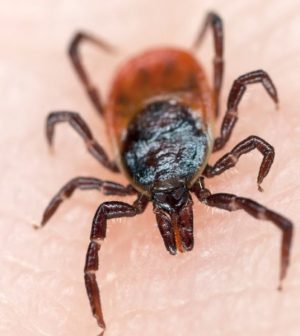- Navigating Your Midlife Crisis: Embracing New Possibilities
- City Raccoons Showing Signs of Domestication
- Mapping the Exposome: Science Broadens Focus to Environmental Disease Triggers
- One Week Less on Social Media Linked to Better Mental Health
- Your Brain Changes in Stages as You Age, Study Finds
- Some Suicide Victims Show No Typical Warning Signs, Study Finds
- ByHeart Formula Faces Lawsuits After Babies Sickened With Botulism
- Switch to Vegan Diet Could Cut Your Greenhouse Gas Emissions in Half
- Regular Bedtime Does Wonders for Blood Pressure
- Dining Alone Could Mean Worse Nutrition for Seniors
Coming This Summer: More Ticks and a Deadly New Tick-Borne Disease

Scientists have a double-shot of bad news about ticks: There’s a new, and potentially fatal, tick-borne illness called Powassan, and this summer looks like it might be one of the worst on record for an increase in the tick population.
“Tick-borne diseases are on the rise, and prevention should be on everyone’s mind, particularly during the spring and summer, and early fall when ticks are most active,” said Rebecca Eisen. She is a research biologist in the U.S. Centers for Disease Control and Prevention’s division of vector-borne diseases.
Laura Goodman, a senior research associate in population medicine and diagnostic sciences at Cornell University, concurred. “It’s going to be a bad season,” she said.
Approximately 75 cases of Powassan disease were reported in the United States over the past 10 years. Most cases have occurred in the Northeast and Great Lakes region, according to the CDC.
Powassan is a virus that can be transmitted through a tick bite. Although rare, Powassan has been spreading, and more cases are likely this year, Goodman said.
Signs and symptoms of Powassan can include fever, headache, vomiting, weakness, confusion, seizures and memory loss. Long-term neurological damage also may occur, according to the CDC.
There’s currently no specific treatment for the disease. People with severe Powassan often need to be hospitalized to receive respiratory support, intravenous fluids or medications to reduce swelling in the brain.
If inflammation of the brain (encephalitis) occurs, the fatality rate is approximately 10 percent, the CDC warns.
There’s no vaccine to prevent Powassan. The best prevention is avoiding ticks.
And that may be harder to do this year, experts at Cornell University explained. Because of a milder winter in the Northeast, a dramatic increase in the tick population is expected in that region and possibly across the northern United States.
Eisen said that “the ability of ticks to survive and reproduce also is influenced by temperature and precipitation. Other factors include, but are not limited to, availability of hosts and suitable habitat, such as wooded or brushy vegetation.”
Ticks that can transmit illnesses have expanded their geographic range and are now being found in places they weren’t seen 20 years ago, she noted.
Reforestation and increased deer populations are contributing to the expanding tick distribution, Eisen said.
Ticks carry not only bacterial diseases such as Lyme, but also viral illnesses like Powassan and parasitic diseases like babesiosis.
Since the late 1990s, the number of reported cases of Lyme disease in the United States has tripled, and the number of counties in the Northeast and upper Midwest that are considered high-risk for Lyme disease has increased by more than 300 percent, Eisen said.
In 2015, about 30,000 cases of Lyme disease were reported in Americans, but the number was likely much higher, according to the CDC.
To protect yourself from a tick-borne infection, the CDC recommends:
- Learning which tick-borne diseases are common in your area.
- Avoiding places with thick vegetation, high grass and leaf litter.
- Walking in the center of trails when hiking.
- Using repellent that contains 20 percent or more DEET on exposed skin for protection that lasts several hours.
- Using products that contain permethrin to treat clothing and gear — such as boots, pants, socks and tents — or wearing clothing pre-treated with permethrin.
- Bathing or showering as soon as possible after potential exposure, to wash off ticks before they bite.
- Removing all attached ticks as soon as possible.
- Treating dogs with products that kill and/or repel ticks.
- Examining gear and pets. Ticks can ride into the home on clothing and pets, then attach to a person later, so carefully examine pets, coats and day packs.
- Drying clothes in a dryer on high heat for 10 minutes to kill ticks on dry clothing after you come indoors. If the clothes are damp, additional time may be needed. If the clothes require washing first, hot water is recommended.
- If the clothes can’t be washed in hot water, tumble dry on low heat for 90 minutes or high heat for 60 minutes. The clothes should be warm and completely dry.
“It’s especially important to take steps to protect yourself and your loved ones, including pets, from ticks during this season, as well as any time during the warmer months when you’re outside,” Eisen said.
More information
For more about tick-borne diseases, visit the U.S. Centers for Disease Control and Prevention.
Source: HealthDay
Copyright © 2025 HealthDay. All rights reserved.










